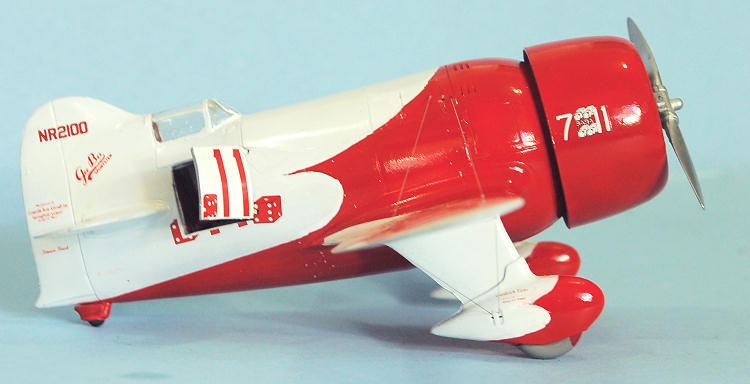
Williams Bros. 1/32 GeeBee R-1
| KIT #: | ? |
| PRICE: | $22.95 |
| DECALS: | Two options |
| REVIEWER: | Tom Cleaver |
| NOTES: |

| HISTORY |
Is there a racer better-known around the world than the Gee Bee Model R?
To most fans of the sport of air racing, as well as all aviation
enthusiasts, it is the quintessential 1930s air racer, with its barrel shape and
bright red and white finish.
Granville Brothers Aircraft Company was founded in 1929 in Springfield,
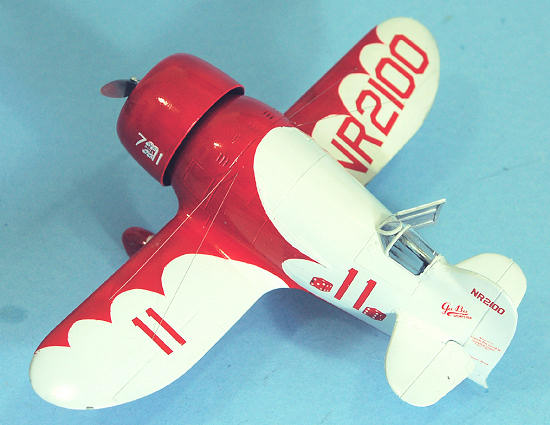 Following the spectacular crash of the first Gee Bee racer, the Model Z,
flown by
Following the spectacular crash of the first Gee Bee racer, the Model Z,
flown by
In 1932, famed distance record-holder Russell Boardman purchased 51
percent of the
While legend has it the airplane was designed with chalk on the concrete
floor of the hangar, the truth is more prosaic.
Chief Engineer Howell "Pete" Miller and Zantford "Granny" Granville spent
three days of wind tunnel testing at New York University, working with Alexander
Klemin, professor of aeronautical engineering, and utilized the most advanced
knowledge available at the time.
The teardrop‑shaped fuselage was found to be the best way to streamline the big
radial engine.
Wind tunnel tests on
fuselages of varying fineness ratios showed that minimum drag was attained at a
fineness ratio of 3.00 to 3.50.
Since the Wasp engine was 54 inches in diameter, the fuselage diameter would be
61 inches at its widest point, with an overall length of 17 feet 9 inches, to
obtain a fineness ratio of 3.50.
Counter-intuitively, the design meant that a large frontal area would create
less drag than a smaller frontal area.
Based on the wind tunnel data, Miller predicted the Model R-1 would have
a top speed of 298 mph, which turned out to be very close, since the actual
airplane had a top speed of 296.2 mph.
The cockpit was located just in front of the vertical stabilizer to give
the pilot better vision while making turns around crowded pylons.
It also turned out that this fuselage acted as an airfoil, an early
“lifting body, allowing the pilot to make “knife-edge turns” right next to the
pylons without losing altitude, which became the secret of its success:
flying the course as low and tight as possible without cutting a pylon is
still the best way to win an air race.
When completed, the airplane was exactly what it looked like: a Pratt &
Whitney R‑1340 engine with wings and a tail attached.
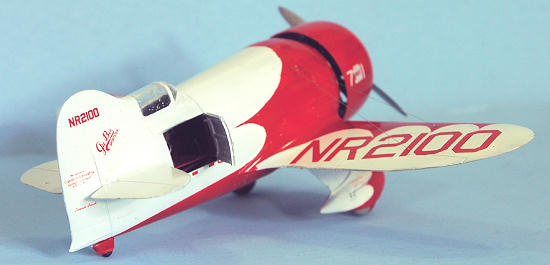 Boardman decided that he would concentrate on the Bendix Trophy race, and
convinced Jimmy Doolittle -
Boardman decided that he would concentrate on the Bendix Trophy race, and
convinced Jimmy Doolittle -
In the 1932 National Air Races, held over Labor Day weekend in Cleveland,
Ohio, Doolittle was not only victorious in the Thompson Race on September 5,
1932, he also lapped his competitors in the process, as he averaged 252.67 miles
per hour over 100 laps.
He then
went on to set a new World Landplane Speed Record of 296.2 mph in the Shell
Speed Dash.
The
The reputation of Gee Bees as “killers” continued when Boardman was
killed in the R-1 during the 1933 Bendix Trophy race.
After taking off from a refueling stop in
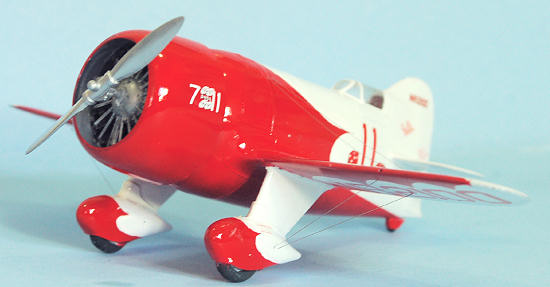 In 1934, the R‑1 was repaired with parts from the R‑2 to create the "Long
Tail Racer."
This Model R also
crashed, though pilot Roy Minor was not severely injured. After yet another
rebuild, the Long Tail Racer was sold to Cecil Allen, who - against the
Granvilles’ advice - modified by installing larger gas tanks aft of the center
of gravity, which made the aircraft unstable in pitch.
Allen took off with a full fuel tank, pulled up, stalled, crashed, and
was killed. After this,
the
aircraft was never rebuilt.
In 1934, the R‑1 was repaired with parts from the R‑2 to create the "Long
Tail Racer."
This Model R also
crashed, though pilot Roy Minor was not severely injured. After yet another
rebuild, the Long Tail Racer was sold to Cecil Allen, who - against the
Granvilles’ advice - modified by installing larger gas tanks aft of the center
of gravity, which made the aircraft unstable in pitch.
Allen took off with a full fuel tank, pulled up, stalled, crashed, and
was killed. After this,
the
aircraft was never rebuilt.
If there was a design flaw to the Gee Bees, it was the use of the Clark-Y
airfoil.
This is an excellent
low-speed airfoil (used by the J-3 Cub, for instance), but not what is needed
for a high-speed, high-weight, high-powered design.
Delmar Benjamin built a replica of the R-2 in the 1980s, with a different
airfoil, and has flown the airplane in air shows for years without a problem.
Planes of
| THE KIT |
To my knowledge, this kit by Williams Brothers, which if I recall
correctly was released about 1973 (I remember seeing someone with one of the
kits at a meeting of the old Golden Gate IPMS, which makes it no later than
early 1974 for me), is the only
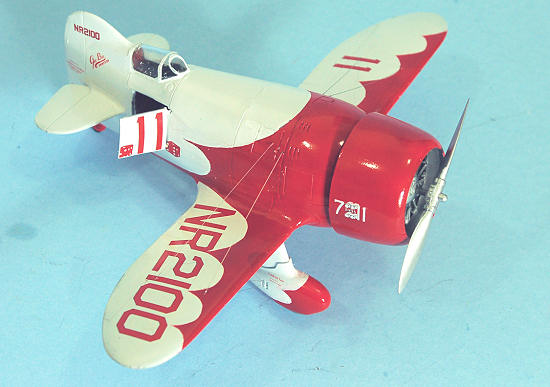 model of the Gee Bee other than the 1/48 kit
originally issued by Hawk back when I was mumblemumble years old, a very long
time ago, back in the early Jurassic (Actually, the copyright stamped on one I
have is 1952).
model of the Gee Bee other than the 1/48 kit
originally issued by Hawk back when I was mumblemumble years old, a very long
time ago, back in the early Jurassic (Actually, the copyright stamped on one I
have is 1952).
This is one of the first, if not the first, Williams Brother racer kit
released, and is still one of the best in terms of production quality.
The one piece wings and horizontal stabilizers are thin, with sharp
trailing edges, and the kit assembles without much if any seam filler if you
take time to test fit carefully before applying glue.
There is a basic cockpit (but racer
cockpits from that era are very basic!), with an instrument panel decal.
The kit decals provide the markings for both the R-1 and R-2.
Additionally, there is a choice of cowlings, though only one engine. In
fact, it is impossible to make an R-2 from this kit if you are so disposed,
since the R-2 had longer-span wings than the R-1, something that is hard to
create here.
Williams Brothers was purchased a few years ago following the death of
the founder, and the kits are being re-released in new boxes with new decals.
This kit showed up at the LHS in the original boxing, with the original
Scale-Master decals.
| CONSTRUCTION |
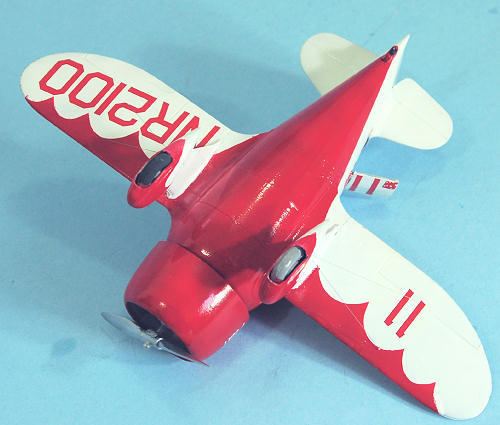 re provided, but there is also a pair of injection-molded
plastic main wheels, which I chose to use.
The nice thing was that by careful test-fitting and assembly before
applying glue, I only used some cyanoacrylate glue for a seam filler along the
upper fuselage. All the other seams disappeared under a scraping with my X-acto.
re provided, but there is also a pair of injection-molded
plastic main wheels, which I chose to use.
The nice thing was that by careful test-fitting and assembly before
applying glue, I only used some cyanoacrylate glue for a seam filler along the
upper fuselage. All the other seams disappeared under a scraping with my X-acto.
| COLORS & MARKINGS |
The decals may have been 30 years old, but they went on without problem
with Micro-Sol.
When they were set,
I washed the model and gave it another coat of Future, since the instructions
stress how smooth and shiny the paint scheme was on the original.
| FINAL CONSTRUCTION |
| CONCLUSIONS |
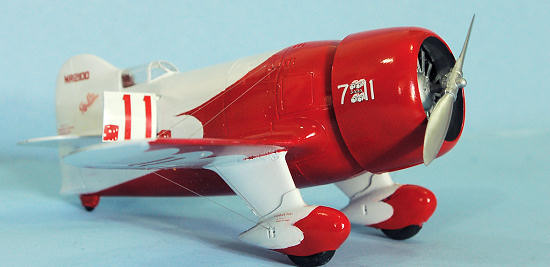 ver release a
kit of this airplane. This kit may be 35 years old, but until I saw this one on the shelf at
the LHS, I had resisted getting one.
I’m glad I waited, since I appreciate it now. Highly recommended.
ver release a
kit of this airplane. This kit may be 35 years old, but until I saw this one on the shelf at
the LHS, I had resisted getting one.
I’m glad I waited, since I appreciate it now. Highly recommended.
March 2011
If you would like your product reviewed fairly and quickly, please contact me or see other details in the Note to Contributors.